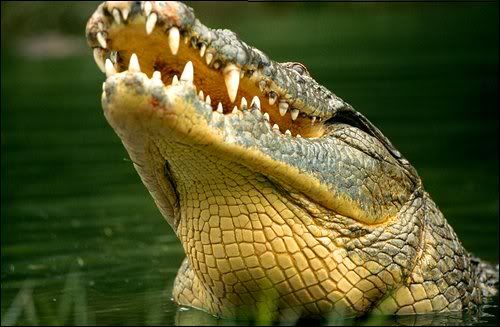|
|
Post by Revenge on Apr 14, 2009 9:57:54 GMT -5
Crocodiles
A Vicious Maneater: The saltwater crocodile is the largest reptile in the world, and perhaps the most dangerous. Along with alligators, saltwater crocodiles are responsible for more human fatalities per year than any other predator on earth.
Made for Water: They are powerful swimmers, expertly adapted to life in the water, where they do almost all of their hunting. Their eyes and nostrils are located on top of their head, which allows them to see and hear prey while partially submerged.
Stalk and Ambush: Saltwater crocodiles prefer to take prey from the water's edge. These patient predators will float for hours on end, eyes focused on the bank, waiting for a thirsty animal to approach for a drink. When a victim is spotted, the crocodile drops below the surface, inches forward to within striking range, then launches out of the water with a violent, bone-crushing attack. Hapless animals that don't get out of the way are dragged beneath the water's surface and drowned.
Underwater Storage: After twisting off a few mouthfuls of flesh, the crocodile will secure the carcass underwater beneath a log or riverbank, allowing it to rot over the course of several days, during which the reptile feeds on its prize at leisure.
DID YOU KNOW?
An Ancient Design: Crocodiles have been around for some 200 million years and have changed very little since the time of the dinosaurs.
Not-So-Gentle Giant: The largest crocodile on record — a saltwater crocodile shot in Queensland, Australia in 1957 — was just over 28 feet and weighed 2,870 pounds.
An Open Invitation: Dozing with its mouth open helps the crocodile cool off. Often, birds gather and pick off bugs and other leftovers from the croc's teeth and skin.
Reptile or Not?: Although classifed as a reptile, crocodiles are more closely related to birds and dinosaurs than they are to most reptile species. |
|
|
|
Post by Revenge on Apr 14, 2009 10:11:29 GMT -5
The Nile Crocodile
Nile Crocodile Profile
The Nile crocodile has a somewhat deserved reputation as a vicious man-eater. The proximity of much of its habitat to people means run-ins are frequent. And its virtually indiscriminate diet means a villager washing clothes by a riverbank might look just as tasty as a migrating wildebeest. Firm numbers are sketchy, but estimates are that up to 200 people may die each year in the jaws of a Nile croc.
Africa's largest crocodilian, these primordial brutes reach a maximum size of about 20 feet (6 meters) and can weigh up to 1,650 pounds (730 kilograms). Average sizes, though, are more in the range of 16 feet (5 meters) and 500 pounds (225 kilograms). They live throughout sub-Saharan Africa, the Nile Basin, and Madagascar in rivers, freshwater marshes, and mangrove swamps.
The diet of the Nile crocodile is mainly fish, but it will attack almost anything unfortunate enough to cross its path, including zebras, small hippos, porcupines, birds, and other crocodiles. It will also scavenge carrion, and can eat up to half its body weight at a feeding.
One unusual characteristic of this fearsome predator is its caring nature as a parent. Where most reptiles lay their eggs and move on, mother and father Nile crocs ferociously guard their nests until the eggs hatch, and they will often roll the eggs gently in their mouths to help hatching babies emerge.
Hunted close to extinction in the 1940s through the 1960s, local and international protections have helped them rebound in most areas. In some regions, though, pollution, hunting, and habitat loss have severely depleted their numbers.
Nile Crocodile Range (In the yellow)
Fast Facts
Type: Reptile
Diet: Carnivore
Average lifespan in the wild: 45 years (est.)
Size: 16 ft (5 m)
Weight: 500 lbs (225 kg)
Group name: Bask (on land) or float (in water)
Did you know?: Mummified crocodiles and crocodile eggs have been discovered in Egyptian tombs.
Protection status: Endangered
Size relative to a 6-ft (2-m) man
|
|
|
|
Post by Revenge on Apr 14, 2009 10:11:59 GMT -5
|
|





